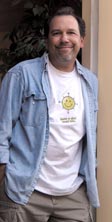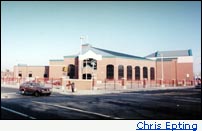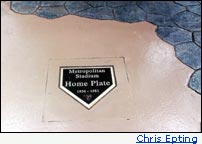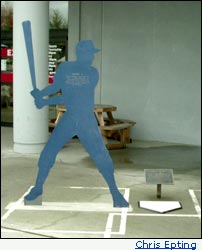On The Road:
|
Directory of all "On the Road" Articles> |
ON the ROAD with CHRIS EPTING
Author & cultural historian
 Chris
Epting is an accomplished
roadtripper, cultural historian, and the author of eight
books including James
Dean Died Here, Marilyn
Monroe Dyed Here, Roadside
Baseball, and Elvis
Presley Passed Here. He is a regular contributor
to a variety of travel publications and the spokesperson
and co-creator for the Hampton Inn's "Hidden
Landmarks" program. Originally from New York,
Chris now lives in Huntington Beach, California, with
his wife Jean and their two children. Chris
Epting is an accomplished
roadtripper, cultural historian, and the author of eight
books including James
Dean Died Here, Marilyn
Monroe Dyed Here, Roadside
Baseball, and Elvis
Presley Passed Here. He is a regular contributor
to a variety of travel publications and the spokesperson
and co-creator for the Hampton Inn's "Hidden
Landmarks" program. Originally from New York,
Chris now lives in Huntington Beach, California, with
his wife Jean and their two children. |
THERE USED TO BE A BALLPARK...
by Chris Epting
So what if gas prices are high? To a road
tripper, that merely means being a bit more selective in where
you choose to go. So with the weather warming up, what better
time to start planning those spring and summer road trips?
For a baseball fan, there's no better time to grab a map,
a
good guidebook, and friends or family to set off in search
of
baseball, both past and present.
I am very happy this year to be back as spokesman for Hampton Inn Hotel's Hidden Landmarks program (part of their award-winng Save-A-Landmark program). Hidden Landmarks is an online travel resource that lets you explore unique, off- the-wall, historic pop culture landmarks around the country. This year we've added DriveAbouts™ which electronically maps specific tours for you. There are 10 different tours, including something I'm passionate about -- baseball history. In addition to what you'll find at Hidden Landmarks, I also wanted to share 10 of my favorite former stadium sites around the country. So grab your mitts and get ready to play where the greats once stood.
1. Where Giants Roamed… The Polo Grounds
West 155th Street and Eight Avenue, Washington Heights, New
York City
[Satellite
Map]
The New York Giants originally played baseball at a city polo
field on 111th Street between Fifth and Sixth Avenues. But
when owner John Brush moved the team here to Coogan's Bluff
in 1891, he kept the name "Polo Grounds." An odd
"bathtub-shaped" ballpark, the Polo Grounds was
home to some of the greatest moments in baseball history,
including Willie Mays's famous catch in the 1954 World Series
and Bobby Thomson's "Shot Heard 'Round the World"
home run to beat the Dodgers in 1951. In 1964, the stadium
was demolished and now the Polo Grounds Towers, a housing
project, occupies the site. The original staircase leading
down to the ticket booth still exists, and a plaque marks
the site where home plate once sat.
2. The First World Series… Huntington
Avenue Grounds
400 Huntington Avenue, on the campus of Northeastern University
in Boston
[Satellite
Map]
Before the 1912 opening of Fenway Park, Huntington Avenue
Grounds was home to the Boston Red Sox. In use for only 11
years, what makes Huntington Avenue Grounds most significant
can be gleaned from the home plate-shaped plaque that site
near the original spot of the base. Dedicated in 1993, the
inscription reads: "On October 1, 1903, the first modern
World Series between the American League champion Boston Pilgrims
(later known as the Red Sox) and the National League champion
Pittsburgh Pirates was played on this site. General admission
tickets were fifty cents. The Pilgrims, led by twenty-eight
game winner Cy Young, trailed the series three games to one
but then swept four consecutive victories to win the championship
five games to three." Now located on the campus of Northeastern
University, there is also a life-size statue of Cy Young located
near where the pitcher's mound used to be (in the Churchill
Hall Mall).
3. Baseball in the City of Brotherly Love…
Connie Mack Stadium
21st St. & Lehigh Avenue, Philadelphia
[Satellite
Map]
Shibe Park opened in 1909 as the home of the Philadelphia
Athletics. A's owner Ben Shibe built the ballpark entirely
of steel and concrete -- an architectural first. Shibe's most
unusual feature was its ornate French Renaissance façade,
complete with a Beaux Arts tower, at the main entrance of
the park. Shibe Park was re-christened Connie Mack Stadium
in 1953, after the legendary manager of the A's. Closed in
1970, a severe fire destroyed much of the interior in 1971,
and the ballpark was mercifully demolished in 1976. Recently,
an historic marker was placed at the site, where a church
now stands.
4. Steel Town Baseball… Forbes Field
230 South Bouquet Street, Pittsburgh
[Satellite
Map]
From 1909-1970, beautiful Forbes Field was the home of the
Pittsburgh Pirates. (Interestingly, in 68 seasons, there was
never a no-hitter pitched here.) Most notably, it was the
scene of one of the most dramatic moments in baseball history:
Bill Mazeroski's Game Seven home run in the 1960 World Series
to beat the Yankees. Though the stadium was torn down in the
early 1970s, some interesting remnants remain here on the
grounds of the University of Pittsburgh. A sizeable part of
the outfield wall still stands -- ivy-covered during summer
-- as does the flagpole. A plaque in the sidewalk marks the
spot where Maz's homer cleared the wall in game seven. And
the last home plate used at Forbes remains on display near
its final location -- only now it's under glass in the hall
at the Quadrangle Building.
5. Nothing Erie About It… League Park
East 66th Street and Lexington Avenue, Cleveland
[Satellite
Map]
On, May 1, 1891, League Park opened with Cy Young pitching
for Cleveland. Lights were never installed at League Park,
and the team moved out after 1946 to the much bigger Municipal
Stadium. This was where Babe Ruth hit his 500th home run,
where the only unassisted triple play in World Series took
place, and where Joe DiMaggio got his last hit in 1941's famous
56-game streak. Though the ballpark was demolished in 1951,
today there are wonderful remnants of the stadium that remain.
The famous two-story ticket booth (and former team offices)
is now a youth center, and a crumbling part of the first base
grandstand still stands -- a "Greek ruins" of baseball.
It's also possible to play in the exact spot where so many
legends from Speaker to Ruth to Cobb once roamed, as the diamond
still sits in the exact place it was when the ballpark was
here. An historic marker is also present.
6. History is in the Cards… Sportsman's
Park
The Herbert Hoover Boys and Girls Club, 2901 North Grand Avenue,
St. Louis
[Satellite
Map]
Starting back in the 1870s, baseball was played at this location.
Around the turn of the century the St. Louis Browns began
playing here at Sportsman's Park, and in 1920, the St. Louis
Cardinals moved in and shared the park until 1953 (when the
Browns moved to Baltimore and became the Orioles). Sportsman's
Park was home to the Cardinals until May 8, 1966. After leaving
the stadium, Anheuser-Busch and August A. Busch, Jr. donated
the property for use as a private recreational facility, the
Herbert Hoover Boy's Club, which opened in 1967. If you stop
by, it's still possible to play on the exact spot where almost
100 years of St. Louis baseball history took place.
7. Want to Hit the Mall?… Metropolitan
Stadium
Mall of America, Crossroads of Interstate 494 and Highway
77, Bloomington, Minnesota
[Satellite
Map]
The Twins played here at "The Met" until 1981. The
stadium, which had also hosted Minnesota Vikings football,
was torn down in 1984 to make room for the world-famous Mall
of America, which now occupies the site. Home plate is marked
with a plaque in its exact spot, now part of the Camp Snoopy
area. As well, a seat from the Metropolitan is bolted to a
wall to mark the spot where a mammoth 520 foot homerun by
Harmon Killebrew landed on June 3, 1967.
8. Houston, We Have a Stadium Site… Buff
Stadium
Finger Furniture Center, 4001 Gulf Freeway, Houston
[Satellite
Map]
This is probably the only furniture store in the world with
a marker on the floor where a home plate used to be. That's
because this is where Buff Stadium used to sit. Buff Stadium,
built in 1928, opened as the home of the Texas League Houston
Buffalos. Damaged by Hurricane Carla in 1961, it was sold
at auction an for just $19,750 and was demolished in 1963.
Then, the Finger Furniture Center was built and a plaque was
laid at the exact spot where the old home plate was located.
It's still there, as is a small sports museum, right in the
store!
9. Lights, Camera, Baseball!… Wrigley
Field
42nd Place and Avalon, Los Angeles
[Satellite
Map]
On April 27, 1925, Wrigley Field opened at the corner of Avalon
Street and 42nd Place in South Central Los Angeles. Owned
by chewing gum magnate William Wrigley, it was partially modeled
after the other Wrigley Field in Chicago. It was home to the
Los Angeles Angels until the early 1960s, but it's famous
for other reasons. Given it's proximity to Hollywood, Wrigley
Field was regularly used for movies such as "Pride of
the Yankees," "The Kid From Left Field," "Damn
Yankees," "It Happens Every Spring," "The
Geisha Boy," and many more. An episode of "The Munsters"
was filmed here, and millions of fans saw Wrigley on TV regularly,
as it was the park used for the 1960s TV show "Home Run
Derby." Today, the former site of Wrigley Field is occupied
by a public park and recreation center.
|
|
10. A Fixer-Upper… Sick's Stadium
Lowe's of Rainier, 2700 Rainier Avenue South, Seattle
[Satellite
Map]
The former site of Sick's Stadium is now a home improvement
store. Sick's Stadium opened here on June 15, 1938. Named
for Rainiers team owner Emil Sick, the 12,000-seat park hosted
minor league baseball until the early 1960s, then was home
to the Major League Seattle Pilots. Demolished in 1979, today
at the former site of Sick's Stadium is a Lowe's Home Improvement
Warehouse. There is a glass display case inside the store
which shows some memorabilia from the Rainiers and Pilots,
and just outside the front door is a bronze home plate with
a metal statue of a player holding a bat.
Chris Epting
April 17, 2005



